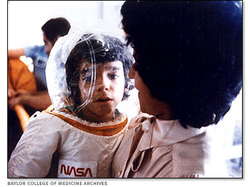Severe Combined Immunodeficiency

Figure 1: David Vetter [8]
Severe Combined Immunodeficiency Disease (SCID) is caused by
a lack of functional T and B lymphocytes, which are cells important to adaptive
immunity [4]. Thirty to fifty
percent of patients who have SCID have B cells which are present but cannot
function, and do not have T cells (T‐B+ SCID). The most common of the T‐B+ SCID types is
caused by mutations to the IL-2RG gene
on the X chromosome. The type of
SCID caused by mutations to the JAK3
gene is autosomal recessive and is the second most common T‐B+ SCID. [5]
The estimate is that 1 in 50,000 newborns have T‐B+ SCID and a survey by the Immune Deficiency Foundation showed they have the best chance of survival (91%) if they receive a bone marrow transplant within three and a half months of being born [5][6]. Without an adaptive immune system children with SCID are susceptible to infection and if they do not receive a bone marrow transplant during early childhood SCID is always fatal (with one exception) [4].
There is one famous example of a child, David Philip Vetter (b. 1971) who survived to age twelve with SCID. He spent the entire twelve years (minus his last fifteen days) living in a germ free “bubble” at the hospital or at home, or after 1977 in a spacesuit designed for him by NASA. David died in 1984 after a failed bone marrow transplant from his sister. [7]
The estimate is that 1 in 50,000 newborns have T‐B+ SCID and a survey by the Immune Deficiency Foundation showed they have the best chance of survival (91%) if they receive a bone marrow transplant within three and a half months of being born [5][6]. Without an adaptive immune system children with SCID are susceptible to infection and if they do not receive a bone marrow transplant during early childhood SCID is always fatal (with one exception) [4].
There is one famous example of a child, David Philip Vetter (b. 1971) who survived to age twelve with SCID. He spent the entire twelve years (minus his last fifteen days) living in a germ free “bubble” at the hospital or at home, or after 1977 in a spacesuit designed for him by NASA. David died in 1984 after a failed bone marrow transplant from his sister. [7]
JAK3

Figure 3: The Roman god Janus [10]
Located on the short arm of chromosome 19 at band 13.1, as seen in Figure 2, the JAK3 gene codes for the JAK3 protein, a member of the Janus Kinase family of proteins [11]. This protein has four domains, two of which work in tandem, which is why the protein family was named after the Roman god Janus who has a face on the front and back of his head. The JAK3 protein itself mostly functions in the hematopoeitic system. [5]
Ideally the JAK3 protein should bind to the cytokine receptor common subunit gamma (also called IL-2RG, encoded by the IL-2RG gene, which is mutated in X‐linked SCID) which allows the receptor to function [5][12]. When JAK3 is mutated and the protein cannot function properly the cytokine receptor also cannot function and cytokine pathways that use this receptor become inoperable. The T cells which depend on these cytokine pathways are unable to develop and B‐cells cannot function. [5]
Click here or on the Protein tab for more information about how the JAK3 protein functions.
References
[1] Left Header Image: http://www.dana.org/news/publications/detail.aspx?id=4274
[2] Center Header Image: http://www.angels.scid.net/2010/06/what‐is‐scid‐nbs/
[3] Right Header Image: http://www.sciencemuseum.org.uk/WhoAmI/FindOutMore/Yourgenes/Howdogenesaffectyourhealth/Whyisstudyinggeneticsimportant/Whatisgenetherapy.aspx
[4] Alberts, B., Johnson, A., & Lewis, J. (2002). The Adaptive Immune System. In Molecular Biology of the Cell (4th ed.). Retrieved from http://www.ncbi.nlm.nih.gov/books/NBK21070/
[5] Notarangelo, L.D., Mella, P., Jones, A., de Saint Basile, G., Savoldi, G., Cranston, T., Vihinen, M., Schumacher, R.F. (2001). Mutations in severe combined immune deficiency (SCID) due to JAK3 deficiency. Human Mutation, 18(4):255–63. doi: 10.1002/humu.1188
[6] Immune Deficiency Foundation. (2008). Electronic References. Retrieved February 5 2011, from http://www.primaryimmune.org/advocacy_center/scid/scid_docs/questions_about_SCID.pdf
[7] http://www.pbs.org/wgbh/amex/bubble/peopleevents/index.html
[8] Figure 1: http://www.pbs.org/wgbh/amex/bubble/gallery/g_05.html
[9] Figure 2: http://www.genecards.org/cgi‐bin/carddisp.pl?id_type=entrezgene&id=3718
[10] Figure 3: http://history.wisc.edu/sommerville/367/367–100.htm
[11] http://www.ncbi.nlm.nih.gov/sites/entrez?db=gene&cmd=Retrieve&dopt=full_report&list_uids=3718
[12] http://www.uniprot.org/uniprot/P31785
Erin Clements, [email protected], Last updated 15 May 2011

